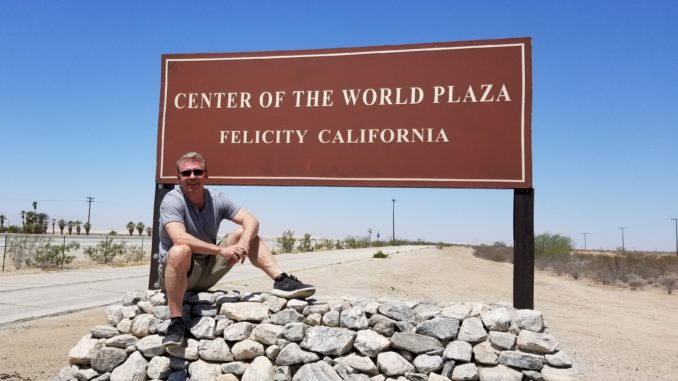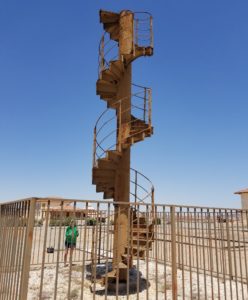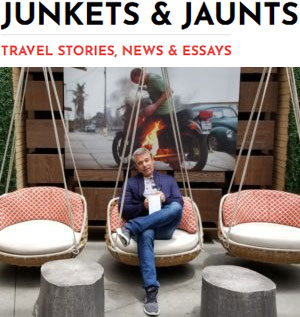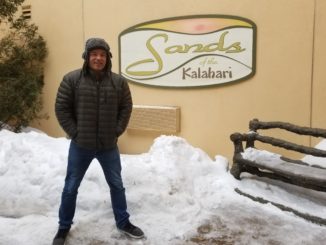

Directives from the GPS app suddenly get sketchy. After bumping along for several miles on a lumbar-testing, pock-marked access road we do eventually arrive, wide-eyed and wary, at the Center of the World.
It’s not a mirage. According to California’s Imperial County Board of Supervisors—and per France’s Institut Geographique National—this way-under-the-radar roadside attraction in the single-digit-population town of Felicity, can officially call itself the Center of the World.
That claim, for argument’s sake, is easily disputable, of course. One could literally pick anywhere on the globe and declare it the center of the world. (Some might contend that President Trump considers himself such.)
The Center of the World/Felicity is just off Interstate 8 in a southeastern California corner of the Sonoran Desert. To the south: the Mexico border. To the east: the Arizona border and the relative metropolis of Yuma.
An eccentric, seemingly well-intentioned labor of love and whimsy, the Center of the World is staffed during the cooler months of December to March. We arrive in June. The place is deserted, but not uncomfortably hot. We drop $6 ($3/person) into the honor box at the entrance.
My wife and I have picked this place as a midway stop for a road trip from San Diego to Scottsdale. I researched it online. It has an official website. Roadside America, Atlas Obscura, even The New York Times, have done writeups.
But as my wife says, “Until we pulled up and saw it in person, I wasn’t sure if it would be here, or if it would have beamed up to some mothership for the summer.”
YOU MIGHT ALSO ENJOY: “Road-Trip Travel Tips.”
What’s at the Center of the World?

The gravel parking lot is empty when we pull in. It’s noticeably clean and well-maintained. There’s an eerie quiet, though. We exit the car and walk onto what could have been used as the movie set for the 1951 sci-fi thriller The Day The Earth Stood Still.
There’s no visible spaceship on the grounds—but it’s not hard to imagine one parked behind the concrete pyramid in the center of the park. Or, in back of the white church built on a manmade hill at the back of the property.
The pyramid. It’s 21 feet tall and made of granite. The inset wooden doors are locked to the public in the summer. Unreachable today, on the floor inside is a bronze plaque with a dot in the middle. In the winter, you can take a tour, step on the dot, and for $2 get a certificate that states you’ve been to the center of the world.
The Church on the Hill. More than 150,000 tons of earth were moved to create the hill (engineered to withstand an earthquake). Up a set of steps, the chapel’s quaint exterior is all white, except for a tall front door painted with a strikingly pretty shade of darkish blue.

You can see the church from I-8 if you’re traveling westbound. Note: At the front of the grounds is a 15-foot sundial. A bronze replica of Michelangelo’s Arm of God (painted on the Sistine Chapel) points to the Church on the Hill.
No, this is not home base to a cult of any sort.
The Stairway to Nowhere. A 25-foot, three-ton section from the original stairway on the Eiffel Tower sits near the entrance to the park. It’s gated off; visitors are not allowed to climb it.
Close to the Stairway is an immense checkerboard made of colored gravel, and, a wood-boxed area of uneven dirt with a sign that reads “Desert Bowling.”
The Post Office. The city of Felicity has a post office. It’s in the park’s main complex near the museum. At the time the post office was dedicated (December 5, 1987) the town’s population was two, but on that day more than 2,300 letters were mailed.
The Museum of History in Granite
At the center of this desert amalgamation is a series of triangular monuments. The monuments are set in 100-foot-long rows, each including roughly 60 polished, red granite panels. Each panel is engraved with one specific story.

The engraved stories are, like the city of Felicity, eclectic. There are odes to California, Arizona and the United States. There’s a long portion detailing the Korean War, and a History of Humanity section. Space is dedicated to the French Foreign Legion. And parachuting. Other topics include: Supreme Court Justice Sandra Day O’Connor. Chef Julia Child. The hamburger. The TV remote control. The moon.
This durable, open-air museum is not going anywhere anytime soon. The panels are steel-reinforced and sunk into 3-foot-deep trenches. Even with exposure to the elements, structural engineers designed the monuments to last for more than 4,000 years.
Indeed, visitors from other planets could, theoretically, have plenty of time to come and tour the museum before earthly wind and sand can erode this spectacle.
The founder of the Center of the World

The founder of Felicity and the Center of the World is Paris-born Jacques-André Istel. He turned 90 this year, and lives here with his wife, Felicia, whom he named the city after.
Istel fled with his family from France to the United States after the Nazis invaded Paris in 1940. He was—as evidenced by deeds here—a free spirit. In the 1950s he worked as a stock analyst on Wall Street—but hated it.
In 1957, he started his company, Parachutes Inc., which built better chutes than ones the military was using. He founded several profitable parachuting schools for civilians and is credited with popularizing this thrill-seeking hobby.
Istel, who served as a lieutenant colonel in the U.S. Marines during the Korean War, had a habit of buying up undervalued land. He bought the property that would become the Center of the World back in 1950, but formally founded the town of Felicity in 1985. By a county-certified vote, he was elected mayor (seemingly for life).
Additions to the Museum of History in Granite—co-written by Istel and his wife (a former Sports Illustrated researcher/reporter)—continue to this day.
What’s the point of the Center of the World?

Weeks after visiting the Center of the World, I find myself struggling to solidify an opinion on this surprisingly inspirational, haphazardly philosophical, unforgettable place.
It’s hard to shake the memory of seeing the “History of Humanity” monument carved with the words of John Donne: “No man is an island, entire of itself. Each is a piece of the continent, a part of the main. Each man’s death diminishes me, for I am involved in all mankind. Therefore, send not to know for whom the bell tolls, it tolls for thee.”
Unfortunately, Istel was not onsite during my visit. And, I can’t reach him by telephone at the number listed on the official Felicity website.
Some insight into the mad (or accidental, or perhaps nonexistent?) genius of Istel is offered in the The New York Times’ writeup. In it, according to Istel’s longtime friend: “‘Jacques will die not knowing why he built that chapel, but also knowing that he had to.’ Honestly, he added, you could say that about everything here.”

“Imagine” the Center of the World
By karma, or by coincidence, when my wife and I leave the Center of the World we play a podcast on the car radio. The podcast host raves about a relatively new Netflix documentary about John Lennon called John And Yoko: Above Us Only Sky.
Recalling this after getting home, I watch the documentary. It offers a deep dive into the making of the former Beatle’s 1971 album Imagine.
Most people are familiar with the album’s haunting title song, which has been called by some, “a utopian manifesto for a progressive movement.”
Here’s how “Imagine” ends:
Imagine no possessions / I wonder if you can / No need for greed or hunger / A brotherhood of man / Imagine all the people sharing all the world, you…
You may say I’m a dreamer / But I’m not the only one / I hope some day you’ll join us / And the world will be as one.
Now, try to imagine all the people sharing all the offerings at the Center of the World.
I wonder if you can. J&J


